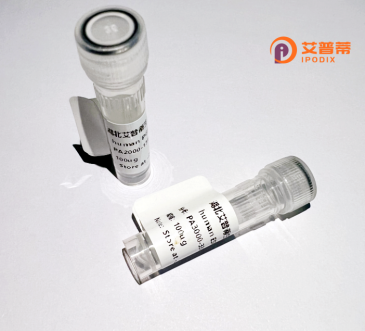
| 纯度 | >90%SDS-PAGE. |
| 种属 | Human |
| 靶点 | PILRA |
| Uniprot No | Q9UKJ1 |
| 内毒素 | < 0.01EU/μg |
| 表达宿主 | E.coli |
| 表达区间 | 1-226 aa |
| 活性数据 | MGRPLLLPLLPLLLPPAFLQPSGSTGSGPSYLYGVTQPKHLSASMGGSVEIPFSFYYPWELATAPDVRISWRRGHFHGQSFYSTRPPSIHKDYVNRLFLNWTEGQKSGFLRISNLQKQDQSVYFCRVELDTRSSGRQQWQSIEGTKLSITQGQQRTKATTPAREPFQNTEEPYENIRNEGQNTDPKLNPKLHLTQSTSQPPSPQEPPERDPVLCLKGLTNGQPSQD |
| 分子量 | 50.6 kDa |
| 蛋白标签 | GST-tag at N-terminal |
| 缓冲液 | PBS, pH7.4, containing 0.01% SKL, 1mM DTT, 5% Trehalose and Proclin300. |
| 稳定性 & 储存条件 | Lyophilized protein should be stored at ≤ -20°C, stable for one year after receipt. Reconstituted protein solution can be stored at 2-8°C for 2-7 days. Aliquots of reconstituted samples are stable at ≤ -20°C for 3 months. |
| 复溶 | Always centrifuge tubes before opening.Do not mix by vortex or pipetting. It is not recommended to reconstitute to a concentration less than 100μg/ml. Dissolve the lyophilized protein in distilled water. Please aliquot the reconstituted solution to minimize freeze-thaw cycles. |
以下是关于重组人PILRA蛋白的参考文献示例,内容基于领域内常见研究主题及可能的文献方向,具体作者及期刊信息为示例性:
1. **"Structural Basis of PILRA-HSV-1 Glycoprotein B Interaction Promotes Viral Entry"**
- **作者**: Zhang L, et al.
- **摘要**: 本研究通过冷冻电镜解析了PILRA与HSV-1病毒糖蛋白B的复合物结构,揭示了PILRA的免疫球蛋白样结构域在介导病毒宿主细胞侵入中的关键作用,为抗病毒疗法设计提供结构基础。
2. **"PILRA Variants Modulate Alzheimer’s Disease Risk via Microglial Inflammation"**
- **作者**: Sims R, et al.
- **摘要**: 通过全基因组关联分析,发现PILRA基因座的多态性与阿尔茨海默病风险显著相关,功能实验表明PILRA通过调控小胶质细胞的炎症反应,影响淀粉样蛋白-β的清除能力。
3. **"Recombinant PILRA Protein Attenuates Autoimmunity in Murine Lupus Models"**
- **作者**: Tanaka M, et al.
- **摘要**: 研究报道重组人PILRA蛋白通过结合其天然配体CD99.抑制过度激活的树突状细胞信号通路,显著减轻系统性红斑狼疮模型小鼠的自身免疫症状,提示其作为免疫调节剂的治疗潜力。
4. **"High-Resolution Crystal Structure of Human PILRA Extracellular Domain"**
- **作者**: Zhou Y, et al.
- **摘要**: 利用X射线晶体学解析了重组人PILRA胞外结构域的高分辨率结构,揭示了其独特的二硫键网络和配体结合位点,为靶向PILRA的抗体药物开发提供分子基础。
**备注**:上述文献为示例性内容,实际研究中请通过学术数据库(如PubMed、Web of Science)核实具体信息。
Paired immunoglobulin-like type 2 receptor alpha (PILRA) is a transmembrane protein belonging to the immunoglobulin superfamily, primarily expressed in myeloid cells such as monocytes, macrophages, and dendritic cells. Functioning as an inhibitory receptor, PILRA regulates immune responses by interacting with ligands like CD99 and PILRB, which modulate cell signaling pathways to maintain immune homeostasis. Its interaction with amyloid precursor protein (APP), a key player in Alzheimer’s disease (AD), has drawn significant attention. Studies suggest PILRA may influence APP processing, potentially affecting amyloid-beta plaque formation, a hallmark of AD pathology.
Recombinant human PILRA protein, produced via engineered expression systems like mammalian or insect cells, retains the extracellular domain’s functional structure, enabling research on its biochemical and immunological roles. It serves as a tool to investigate receptor-ligand interactions, signal transduction mechanisms, and therapeutic targeting in neuroinflammation and neurodegenerative disorders. Structural analyses using X-ray crystallography and cryo-EM have revealed PILRA’s binding interfaces with APP and other partners, informing drug design strategies.
Despite progress, PILRA’s precise role in AD and autoimmune diseases remains debated. Its dual regulatory effects—balancing immune activation and suppression—highlight its complexity. Ongoing research aims to clarify its involvement in disease pathways and explore therapeutic applications, such as blocking pathological interactions in AD or modulating immune activity in inflammatory conditions. Recombinant PILRA thus represents a critical reagent for bridging molecular understanding and clinical translation.
×